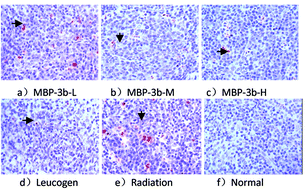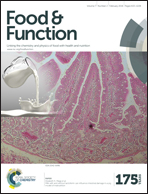Whole body radioprotective effect of phenolic extracts from the fruits of Malus baccata (Linn.) Borkh†
Abstract
This study was designed to evaluate the radioprotective effect of phenolics extracted from the fruits of Malus baccata (Linn.) Borkh. (MBP-3b) against damage induced by 60Co γ-irradiation in vivo. MBP-3b could significantly improve the activity of endogenous antioxidant enzymes and the T-AOC, as well as reduce the MDA level in the liver and kidneys of irradiated mice. In addition, pretreatment with MBP-3b at a dose of 150 mg per kg bw could significantly enhance immunomodulation activity by promoting the proliferation of spenocytes and monocyte phagocytosis. The administration of MBP-3b prevented the decline induced by radiation of haematological parameters (WBC, RBC, PLT and HGB). Furthermore, MBP-3b could protect spenocytes from radiation-induced damage by inhibiting cell apoptosis. The results indicated that MBP-3b possesses strong whole body radioprotective and immunomodulatory activities. The main constituents of MBP-3b were tentatively identified as delphinidin-3,5-diglucoside, cyanidin-3-glucoside, chlorogenic acid, proanthocyanidin C1, quercetin-3-galactoside, quercetin-3-glucoside, quercetin-3-xyloside/arabinoside, phloretin-2-xyloseglucoside, quercetin-3-rhamnoside and phlorizin. MBP-3b could be used as a probable radioprotector against gamma radiation induced oxidative damage.


 Please wait while we load your content...
Please wait while we load your content...